- europages
- >
- COMPANIES - SUPPLIERS - SERVICE PROVIDERS
- >
- extruded profiles
Results for
Extruded profiles - Import export

ROLLON GMBH
Germany
Uniline System is a family of pre-assembled linear units boasting a compact size and high speed ensured by the COMPACT RAIL roller bearings, mounted on a self-sustaining extruded aluminum profile. The linear units are driven by a steel reinforced polyurethane belt system. The horizontal seals and the raceway cleaners fitted on both ends of the carriage ensure full protection from dirt. The linear actuator profile is compatible with an endless number of widely available standard fixing accessories. The motor can be connected to the units by means of a full or a hollow shaft Up to 3,000mm strokes Sizes from 40 x 51.5mm up to 100 x 122.5mm Versions available with long sliders and multiple sliders Using linear rails from the COMPACT RAIL family ensures excellent performance in terms of speed and life. The rails in the linear axes of the four product series are laid out in different combinations to meet all application requirements. Using long or multiple sliders increases the...
Request for a quote
ALUMINIUMWERK UNNA AG
Germany
In the aluminium industry, the porthole extrusion process is the standard method for the production of extruded tubes and profiles. The process is limited to a number of aluminium alloys. However, most of the commercially available medium strength aluminium alloys such as EN AW-6060 or EN AW-6082 can be extruded by porthole extrusion.
Request for a quote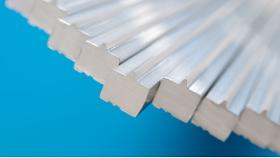
ALUMINIUMWERK UNNA AG
Germany
With the unique extrusion process, ALUnna has the capability to produce continuous lengths of extruded profiles. Unlike the conventional extrusion process, the continuous extrusion process does not use billets. Instead, raw material is fed into the process from a coil. This process is especially useful for the production of small extrusion profiles used as spacer bars in alloys EN AW-1050A / 1350A or EN AW-3103/3003. If necessary, there is an option to apply a draw pass to the spacer bar profile using an in-line Schumag continuous drawing machine in order to achieve the final dimension and the most demanding of tolerances.
Request for a quote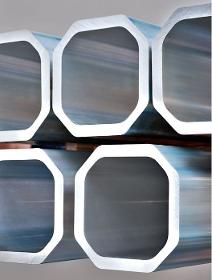
ALUMINIUMWERK UNNA AG
Germany
Not all extruded profiles are required to be circular in shape! Whether it is a seamless or porthole hollow-profile, at ALUnna, we have a multitude of possibilities. Simple profiles, such as a solid profile or an angle profile, are also available. On some profiles we may have the possibility to further improve the dimensional tolerances by adding a subsequent drawing step to achieve final dimensions. In addition to round tube, shaped, square or rectangular tubes in both medium strength and high-strength alloys can be produced.
Request for a quote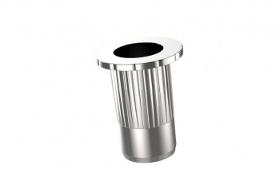
SFS GROUP GERMANY GMBH
Germany
Fields of application: Extruded aluminum profiles with one-sided accessibility, such as. • sills/side members • safety systems • structural profiles Product portfolio: • Steel M6 with toothing • Steel M8 with toothing • Steel M10 with toothing Customer benefits: • Economical: Increased cost-effectiveness compared to hexagonal blind rivet nuts • Process reliability: Increase in process reliability and compensation of process fluctuations • Fast: Reduction of costs and process time per joining point • Customizable: Product-specific adaptation to the application, surface coating according to customer requirements • Compatible in the overall GESIPA® system: Can be combined with other GESIPA® innovations
Request for a quote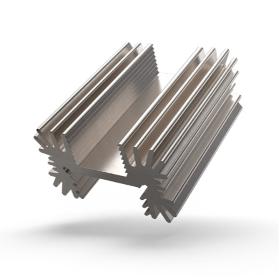
SEIFERT ELECTRONIC GMBH
Germany
Maximum heat dissipation using PC board heat sinks in minimal board space. Seifert electronic GmbH offers custom heat sinks for use in the board area – precisely measured and flexibly adapted to your requirements. The wide standard range of Seifert electronic includes PC heat sinks in all common designs. We provide various heat sink models such as snap-on heat sinks made of strip material, extruded heat sinks, die-cast heat sinks, as well as finger heat sinks and U-shaped heat sinks, along with the corresponding accessories like mounting clips for fastening. Extruded profile heat sinks are considered classics among PC board heat sinks. We gladly recommend them for use in the board area as they are versatile and can dissipate relatively large amounts of heat.
Request for a quote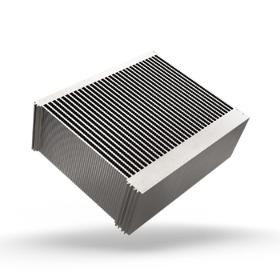
SEIFERT ELECTRONIC GMBH
Germany
High-performance heat sinks from Seifert electronic are exclusively designed for forced cooling applications. The powerful heat sinks from the Vario and DKL series impress with their large cooling surfaces. Utilizing a finned construction, rib spacing can be manufactured that is not achievable with conventional extruded profiles. Thanks to maximized surface area with the same weight, a high-performance heat sink delivers above-average cooling performance per unit volume. We have patented our proprietary compression geometry at Seifert electronic. In this process, individual fins are precisely cold-pressed into a heat sink without the use of adhesives. Heat conduction in the finned heat sinks occurs directly from the base to the fins, without any thermal transition as seen with pressed-in ribs into a solid base. Custom mounting holes can be incorporated into the pressed, surface-milled base.
Request for a quote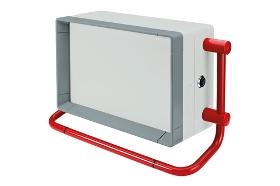
ROLEC GEHÄUSE-SYSTEME GMBH
Germany
aluFACE is an extremely versatile and flexible command enclosure available in six different versions as die-cast aluminium with a frame made from extruded aluminium profiles. Ideal for all types of industrial operating and display technology. The interior contains pre-installed fastening domes for circuit boards, supporting rails or mounting plates. Matching suspension arm systems can be found in the relevant product category on the ROLEC website.
Request for a quote
GESCO-METALL GMBH SCHOTTENHAMML-BIEGETECHNIK
Germany
We manufacture window sills for round windows from extruded aluminium profiles. Special designs on request Special overhangs between 60 mm and 270 mm Overhangs greater than 270 mm Arched circular and with or without water outflow pipe in the upper semicircle Arched more or less than 180° With an incline of up to 7° Arched horizontally with and without an incline
Request for a quote
BETONBAU GMBH UND CO. KG
Germany
False floors We supply different false floors for classic applications which utilise a modular unit with an integrated false floor for cables. System false floors from Betonbau are used in local substations, transfer and transformer stations and switchgear houses. These floors are particularly flexible, can be adapted to precisely suit your room and switch cabinet layout and conform to DIN VDE 0101. We can fit your floor with buoyancy protection where necessary to minimise in as far as possible the effects of an internal malfunction on operators. Key locking is realised in the false floor profile, and the keys can only be withdrawn in the locked position. The design has been tested for accidental arcing in compliance with DIN EN 62271-202. The Betonbau system consists of extruded aluminium profiles and/or galvanised steel profiles and galvanised steel supports with height adjustment designed to suit the switchgear to be integrated. The accessible surface is covered with...
Request for a quote
PROPACK DICHTUNGEN UND PACKUNGEN AG
Germany
PTFE Powder with Graphite, Extruded Profile Practical useful application data: max. temperature: +180 °C Characteristics Good pliability, prevents wear of shafts through embedding of abrasive materials The use of bullrings is required Operating range Pressure [p max]: 10 bar, Velocity [v max]: 12 m/s Pressure [p max]: 20 bar Temperature: t = -100… +250 °C pH: 0 - 14 Density: 1.90 g/cm³ Practical useful application data: max. temperature: +180 °C Main application Valves Gate valves Flanges Agitators Centrifugal pumps Lids Suitable for Cold and hot water Alkaline solutions Acids Oils Grease Bitumen Asphalt Crystalline and abrasive media Food industry Variant S 50 Propaflon White made out of pure PTFE
Request for a quote
TWK-ELEKTRONIK GMBH
Germany
The displacement transducers operate according to the principle of run time measurement between two points of a magnetostrictive waveguide. One point is determined by a moveable position magnet, whose distance from the null point corresponds to the section to be measured. The run time of an emitted impulse is directly proportionate to this section. Conversion to a measuring signal takes place in the downstream electronics. The waveguide is housed in a pressure-resistant stainless steel tube or extruded profile. To the rear of this is a die-cast aluminium housing containing the electronics in SMD technology. In the rod version, the position magnet is located in a ring, which is guided over the rod without contact. In the profile version, it is located either in a slider, which is linked to the moving part of the machine via a ball joint, or it moves as a liftable position magnet, without wear, over the profile.
Request for a quote
TWK-ELEKTRONIK GMBH
Germany
The displacement transducers operate according to the principle of run time measurement between two points of a magnetostrictive waveguide. One point is determined by a moveable position magnet, whose distance from the null point corresponds to the section to be measured. The run time of an emitted impulse is directly proportionate to this section. Conversion to an analogue measuring signal takes place in the downstream electronics. The waveguide is housed in a pressure-resistant stainless steel tube or extruded profile. To the rear of this is a die-cast aluminium housing containing the electronics in SMD technology. Electrical connection is implemented via a circular connector. In the rod version, the position magnet is located in a ring, which is guided over the rod without contact. In the profile version, it is located either in a slider, which is linked to the moving part of the machine via a ball joint, or it moves as a liftable position magnet, without wear, over the profile.
Request for a quote
TWK-ELEKTRONIK GMBH
Germany
The displacement transducers operate according to the principle of run time measurement between two points of a magnetostrictive waveguide. One point is determined by a moveable position ring, whose distance from the null point corresponds to the section to be measured. The run time of an emitted impulse is directly proportionate to this section. Conversion to a displacement signal takes place in the downstream electronics. The waveguide is housed in a pressure-resistant stainless steel tube or extruded profile. To the rear of this is a die-cast aluminium housing containing the electronics in SMD technology. In the rod version, the position magnet is located in a ring, which is guided over the rod without contact. In the profile version, it is located either in a slider, which is linked to the moving part of the machine via a ball joint, or it moves as a liftable position magnet, without wear, over the profile.
Request for a quote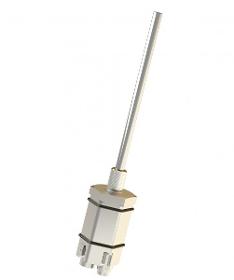
TWK-ELEKTRONIK GMBH
Germany
The displacement transducers operate according to the principle of run time measurement between two points of a magnetostrictive waveguide. One point is determined by a moveable position magnet, whose distance from the null point corresponds to the section to be measured. The run time of an emitted impulse is directly proportionate to this section. Conversion to a digital measuring signal takes place in the downstream electronics. The waveguide is housed in a pressure-resistant stainless steel tube or extruded profile. To the rear of this is a die-cast aluminium housing containing the electronics in SMD technology. In the rod version, the position magnet is located in a ring, which is guided over the rod without contact. In the profile version, it is located either in a slider, which is linked to the moving part of the machine via a ball joint, or it moves as a liftable position magnet, without wear, over the profile.
Request for a quote
TWK-ELEKTRONIK GMBH
Germany
The displacement transducers operate according to the principle of run time measurement between two points of a magnetostrictive waveguide. One point is determined by a moveable position magnet, whose distance from the null point corresponds to the section to be measured. The run time of an emitted impulse is directly proportionate to this section. Conversion to an analogue measuring signal takes place in the downstream electronics. The waveguide is housed in an extruded aluminium profile. The electronics is housed in a die-cast aluminium sensor head. Electrical connection is implemented via a circular connector. The position magnet is located either in a slider, which is linked to the moving part of the machine via a ball joint, or it moves as a liftable position magnet, without wear, over the profile.
Request for a quote
TWK-ELEKTRONIK GMBH
Germany
The displacement transducers operate according to the principle of run time measurement between two points of a magnetostrictive waveguide. One point is determined by a moveable position magnet, whose distance from the null point corresponds to the section to be measured. The run time of an emitted impulse is directly proportionate to this section. Conversion to a digital measuring signal takes place in the downstream electronics. The waveguide is housed in a pressure-resistant stainless steel tube or extruded profile. To the rear of this is a die-cast aluminium housing containing the electronics in SMD technology. In the rod version, the position magnet is located in a ring, which is guided over the rod without contact. In the profile version, it is located either in a slider, which is linked to the moving part of the machine via a ball joint, or it moves as a liftable position magnet, without wear, over the profile.
Request for a quoteDo you sell or make similar products?
Sign up to europages and have your products listed

TWK-ELEKTRONIK GMBH
Germany
The displacement transducers operate according to the principle of run time measurement between two points of a magnetostrictive waveguide. One point is determined by a moveable position magnet, whose distance from the null point corresponds to the section to be measured. The run time of an emitted impulse is directly proportionate to this section. Conversion to an analogue measuring signal takes place in the downstream electronics. The waveguide is housed in a pressure-resistant stainless steel tube or extruded profile. To the rear of this is a die-cast aluminium housing containing the electronics in SMD technology. Electrical connection is implemented via a circular connector. In the rod version, the position magnet is located in a ring, which is guided over the rod without contact. In the profile version, it is located either in a slider, which is linked to the moving part of the machine via a ball joint, or it moves as a liftable position magnet, without wear, over the profile.
Request for a quote
TWK-ELEKTRONIK GMBH
Germany
The displacement transducers operate according to the principle of run time measurement between two points of a magnetostrictive waveguide. One point is determined by a moveable position magnet, whose distance from the null point corresponds to the section to be measured. The run time of an emitted impulse is directly proportionate to this section. Conversion to a measuring signal takes place in the downstream electronics. The waveguide is housed in a pressure-resistant stainless steel tube or extruded profile. To the rear of this is a die-cast aluminium housing containing the electronics in SMD technology. In the rod version, the position magnet is located in a ring, which is guided over the rod without contact. In the profile version, it is located either in a slider, which is linked to the moving part of the machine via a ball joint, or it moves as a liftable position magnet, without wear, over the profile.
Request for a quote
TWK-ELEKTRONIK GMBH
Germany
The displacement transducers operate according to the principle of run time measurement between two points of a magnetostrictive waveguide. One point is determined by a moveable position magnet, whose distance from the null point corresponds to the section to be measured. The run time of an emitted impulse is directly proportionate to this section. Conversion to a digital measuring signal takes place in the downstream electronics. The waveguide is housed in a pressure-resistant stainless steel tube or extruded profile. To the rear of this is a die-cast aluminium housing containing the electronics in SMD technology. Electrical connection is implemented via a circular connector. In the rod version, the position magnet is located in a ring, which is guided over the rod without contact. In the profile version, it is located either in a slider, which is linked to the moving part of the machine via a ball joint, or it moves as a liftable position magnet, without wear, over the profile
Request for a quote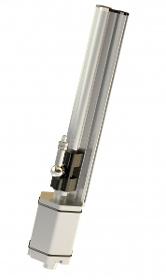
TWK-ELEKTRONIK GMBH
Germany
The displacement transducers operate according to the principle of run time measurement between two points of a magnetostrictive waveguide. One point is determined by a moveable position magnet, whose distance from the null point corresponds to the section to be measured. The run time of an emitted impulse is directly proportionate to this section. Conversion to a digital measuring signal takes place in the downstream electronics. The waveguide is housed in a pressure-resistant stainless steel tube or extruded profile. To the rear of this is a die-cast aluminium housing containing the electronics in SMD technology. Electrical connection is implemented via a circular connector. In the rod version, the position magnet is located in a ring, which is guided over the rod without contact. In the profile version, it is located either in a slider, which is linked to the moving part of the machine via a ball joint, or it moves as a liftable position magnet, without wear, over the profile.
Request for a quote
TWK-ELEKTRONIK GMBH
Germany
The displacement transducers operate according to the principle of run time measurement between two points of a magnetostrictive waveguide. One point is determined by a moveable position magnet, whose distance from the null point corresponds to the section to be measured. The run time of an emitted impulse is directly proportionate to this section. Conversion to an analogue measuring signal takes place in the downstream electronics. The waveguide is housed in a pressure-resistant stainless steel tube or extruded profile. To the rear of this is a die-cast aluminium housing containing the electronics in SMD technology. Electrical connection is implemented via a circular connector. In the rod version, the position magnet is located in a ring, which is guided over the rod without contact. In the profile version, it is located either in a slider, which is linked to the moving part of the machine via a ball joint, or it moves as a liftable position magnet, without wear, over the profile.
Request for a quote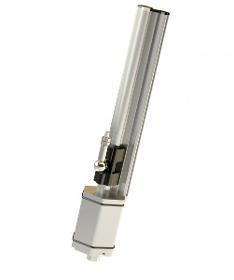
TWK-ELEKTRONIK GMBH
Germany
The displacement transducers operate according to the principle of run time measurement between two points of a magnetostrictive waveguide. One point is determined by a moveable position magnet, whose distance from the null point corresponds to the section to be measured. The run time of an emitted impulse is directly proportionate to this section. Conversion to an analogue measuring signal takes place in the downstream electronics. The waveguide is housed in a pressure-resistant stainless steel tube or extruded profile. To the rear of this is a die-cast aluminium housing containing the electronics in SMD technology. Electrical connection is implemented via a circular connector. In the rod version, the position magnet is located in a ring, which is guided over the rod without contact. In the profile version, it is located either in a slider, which is linked to the moving part of the machine via a ball joint, or it moves as a liftable position magnet, without wear, over the profile.
Request for a quote
DIENER ELECTRONIC GMBH & CO. KG
Germany
The Vacuum Chamber VC P110x120 is made of a unique, flexible chamber system based on extruded aluminium profiles. The three meter long profiles are cut to the desired length and equipped with a bolted rear wall and a door. Slits are provided in the side walls of the profile for easy insertion of the product carriers. ✓ Flexible length of max. 3 meters ✓ Very fast delivery because only door and back wall must be supplemented ✓ Low-cost ✓ Low-weight ✓ Low desorption of the aluminium, therefore also suitable for high vacuum ✓ Excellent thermal conduction ✓ Highly clean processes possible, e.g. in the semiconductor field ✓ Easy operation ✓ Easy attachment to the existing division bars Vacuum chamber specifications Internal dimensions Length: up to 3000 mm (standard: 300 mm, 600 mm) Width: 110 mm Height: 120 mm Front panel (optional): 5 U (1 U = 44.45 mm) Connections 3 x KF 16 Zusätzliche Flansche in beliebiger Position möglich
Request for a quote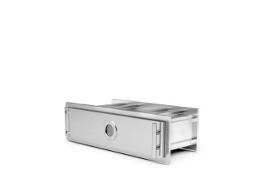
DIENER ELECTRONIC GMBH & CO. KG
Germany
The Vacuum Chamber VC P572X125 is made of a unique, flexible chamber system based on extruded aluminium profiles. The three meter long profiles are cut to the desired length and equipped with a bolted rear wall and a door. ✓ Flexible length of max. 3 meters ✓ Very fast delivery because only door and back wall must be supplemented ✓ Low-cost ✓ Low-weight ✓ Low desorption of the aluminium, therefore also suitable for high vacuum ✓ Excellent thermal conduction ✓ Highly clean processes possible, e.g. in the semiconductor field ✓ Easy operation ✓ Easy attachment to the existing division bars Vacuum chamber specifications Internal dimensions Length: up to 3000 mm (standard: 300 mm, 650 mm) Width: 572 mm Height: 125 mm Connections 1 x KF 16 4 x KF 40 Additional flanges possible in any position
Request for a quote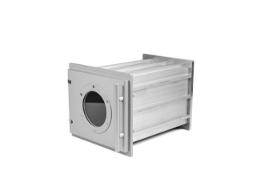
DIENER ELECTRONIC GMBH & CO. KG
Germany
The Vacuum Chamber VC P240X240 is made of a unique, flexible chamber system based on extruded aluminium profiles. The three meter long profiles are cut to the desired length and equipped with a bolted rear wall and a door. Slits are provided in the side walls of the profile for easy insertion of the product carriers. ✓ Flexible length of max. 3 meters ✓ Very fast delivery because only door and back wall must be supplemented ✓ Low-cost ✓ Low-weight ✓ Low desorption of the aluminium, therefore also suitable for high vacuum ✓ Excellent thermal conduction ✓ Highly clean processes possible, e.g. in the semiconductor field ✓ Easy operation ✓ Easy attachment to the existing division bars Vacuum chamber specifications Internal dimensions Length: up to 3000 mm (standard: 420 mm, 600 mm) Width: 240 mm Height: 240 mm Front panel (optional): 8 U (1 U = 44.45 mm) Connections 2 x KF 16 3 x KF 40 Additional flanges possible in any position
Request for a quote
DIENER ELECTRONIC GMBH & CO. KG
Germany
The Vacuum Chamber VC P150x160 is made of a unique, flexible chamber system based on extruded aluminium profiles. The three meter long profiles are cut to the desired length and equipped with a bolted rear wall and a door. Slits are provided in the side walls of the profile for easy insertion of the product carriers. ✓ Flexible length of max. 3 meters ✓ Very fast delivery because only door and back wall must be supplemented ✓ Low-cost ✓ Low-weight ✓ Low desorption of the aluminium, therefore also suitable for high vacuum ✓ Excellent thermal conduction ✓ Highly clean processes possible, e.g. in the semiconductor field ✓ Easy operation ✓ Easy attachment to the existing division bars Vacuum chamber specifications Internal dimensions Length: up to 3000 mm (standard: 325 mm, 600 mm) Width: 150 mm Height: 160 mm Front panel (optional): 6 U (1 U = 44.45 mm) Connections 4 x KF 16 1 x KF 40 Additional flanges possible in any position
Request for a quote
DIENER ELECTRONIC GMBH & CO. KG
Germany
Specially developed for use under high vacuum, our vacuum chamber VC P400x400 HV is made of a unique, flexible chamber system based on extruded aluminium profiles. The three-metre long profiles are cut to the required length and fitted with a screwed rear wall, as well as a door. Unlike our standard VC P400x400, the VC P 400x400 HV has no slots in the side walls. ✓ Flexible length of max. 3 meters ✓ Very fast delivery because only door and back wall must be supplemented ✓ Low-cost ✓ Low-weight ✓ Low desorption of the aluminium, therefore also suitable for high vacuum ✓ Highly clean processes possible, e.g. in the semiconductor field ✓ Easy operation ✓ Easy attachment to the existing division bars Vacuum chamber specifications Internal dimensions Length: up to 3000 mm (standard: 625 mm) Width: 400 mm Height: 400 mm Connections 1 x KF 16 6 x KF 40 Additional flanges possible in any position
Request for a quote
DIENER ELECTRONIC GMBH & CO. KG
Germany
The Vacuum Chamber VC P700D is made of a unique, flexible chamber system based on extruded aluminium profiles. The three meter long profiles are cut to the desired length and equipped with a bolted rear wall and a door. ✓ Flexible length of max. 3 meters ✓ Very fast delivery because only door and back wall must be supplemented ✓ Low-cost ✓ Low-weight ✓ Low desorption of the aluminium, therefore also suitable for high vacuum ✓ Excellent thermal conduction ✓ Highly clean processes possible, e.g. in the semiconductor field ✓ Easy operation ✓ Easy attachment to the existing division bars Vacuum chamber specifications Internal dimensions Length: up to 3000 mm (standard: 1000 mm, 1400 mm) Inner diameter: 640 Ø Outer diameter: 700 Ø Front panel (optional): 18 U (1 U = 44.45 mm) Connections 2 x KF 16 2 x KF 40 2 x ISO K 63 Additional flanges possible in any position
Request for a quoteResults for
Extruded profiles - Import exportNumber of results
34 ProductsCountries
Company type